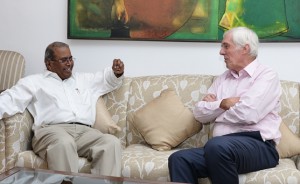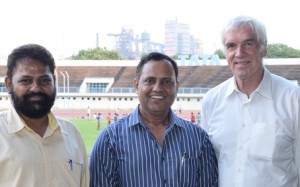23rd April 2013
The heart of India’s largest business – brimming with wide streets and parks
A number of the Tata Group’s top executives have said that you can’t understand their Group until you have visited Jamshedpur. I confess at first I had little idea where the place was, but after a warm invitation from Messrs Muthuraman and Nerurkar, Vice Chairman and Managing Director respectively of Tata Steel, I soon found out much more.
 The city – with a population of around 1 million or more it is that – is some 250 kilometres north of Kolkata. The short flight quickly reveals that it is in a rural area, surrounded just before you arrive by some gentle hills and, at least in April, dried up river beds. Then the enormity of what Tata has developed hits you, with the first sight of a vast steelworks, and almost as big a motor plant.
The city – with a population of around 1 million or more it is that – is some 250 kilometres north of Kolkata. The short flight quickly reveals that it is in a rural area, surrounded just before you arrive by some gentle hills and, at least in April, dried up river beds. Then the enormity of what Tata has developed hits you, with the first sight of a vast steelworks, and almost as big a motor plant.
The concept for the city, founded over 100 years ago, was the dream of Tata’s revered founder, Jamsetji Tata, and its location was chosen because of access to major deposits of iron ore. After discussions in the UK and US he proposed a new steel town for India and Tata, and writing to his son, set out his plan:
“Be sure to lay wide streets planted with shady trees, be sure there is plenty of space for lawns and gardens, reserve large areas for football, hockey and parks,” he wrote.
Sadly Jamsetji didn’t live to see his vision become a reality, but his son Dorab could not have followed the precepts more carefully, and if either could see their city today they would be proud that their successors have kept, despite huge expansion , to their initial aims. In an astonishing pace of development the steel plant can now produce over 10 Mt. of crude steel a year, compared to 6Mt just five years ago. As some of the senior executives noted wryly the new operations at Jamshedpur contrast sharply with the difficult conditions for the steel industry in Europe where, Port Talbot apart, expansion is not on the agenda.
The wide streets and parks of the founder’s dream have remained, and Jamshedpur is often listed as one of the most liveable cities in India. Before work, parks and sports facilities are full of cricket, soccer and others sports enthusiasts, and the city boasts a superb stadium. While I was visiting it was hosting the national archery championship, a sport that Tata Steel sponsors in India. There is also a very appropriate link to a British city, Sheffield, with the Tata Steel Soccer Academy welcoming teachers from Sheffield United for the forty lucky young players who are sponsored by the Group for two years to live, study and play soccer before many of them turn professional.
Inevitably, in a city of a million, there are occasional problems, and the pressures on youth to perform has led to some suicides. Tata have also looked carefully at their provision of services for the city, and concluded that these should be outsourced rather than run by the Group, so an independent company has now taken responsibility for municipal facilities. Despite numerous debates the City remains one of the few which has no elected Municipal Council. Tata Steel retains close links to, and support for, a range of tribal and other minority groups in and around the city.
For the vast majority of people living in Jamshedpur – including the many who have chosen to retire there – it is city which offers one of the best conceivable environments to live and work. There are doubtless comparisons with US cities where a single corporation dominates an urban community, and the closest British example I could think of was Bournville in the West Midlands, where chocolate manufacturer Cadbury’s provided a rich variety of facilities, hospitals and housing – just as Tata does – to all its employees. There isn’t a major corporation dominating Welwyn Garden City’s inhabitants, but it isn’t too far-fetched either to compare living standards in that planned community to Jamshedpur – with one huge difference: the inhabitants of Jamshedpur are producing daily steel and commercial vehicles in two of the largest plants across India.
Jamsetji Tata would be proud of what his successors and their employees have managed to create and maintain. Little wonder all the inhabitants of the city turn out in their thousands every year to mark Founder’s Day. He was, as India’s first Prime Minister Jawaharlal Nehru said, “one of the big founders of modern India”.
“We also make steel”. Development of communities has always been part of Business strategy of Tata Businesses, making them sustainable. Way to go!
Sir, how touching it is to read about what you have written about the Tata Group , with particular reference to Tata Steel Jamshedpur. Thank you so much for visiting us. Our Motto is simple: ” The purpose of our business is to keep Communities Happy “.
With warm regards
Farzan
Good and inspiring note.
However, the town is as worse to its citizens like those of other B-class Indian city.
Mr Peter must be seated in rear seat of a car while visiting places in Jamshepur, hence his view is different than mine.
I visited this city 12 times during last year 2012.
It is very difficult to self-drive car due to very high traffic which is not regulated by properly trained traffic police.
Motor-Bikes follow their own rule while driving on the roads.
Can not walk on the foot-path , it is throng by thrift sellers.
Can not take a city bus, ultra crowded with ticket collector / driver smoking local cigarette.
Un-organised trips run by local group with 3-wheeler tutu kind service, who keep chasing people to gather passengers as much they can fit in the tutu.
Prices of all common utility is high , due to thriving business in the city.
I would avoid visiting this place except essential business trips.
Not a choice for settling down at all.